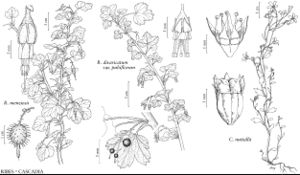Cascadia
Amer. J. Bot. 14: 38, figs. 1, 2. 1927 ,.
| Taxon | Illustrator ⠉ | |
|---|---|---|
 | Ribes menziesii Ribes divaricatum Ribes divaricatum var. pubiflorum Cascadia Cascadia nuttallii | Barbara Alongi Barbara Alongi Barbara Alongi Linny Heagy Linny Heagy |
Herbs, annual; herbage glabrous or sparsely red stipitate-glandular. Flowering-stems trailing or suberect, leafy, 4–40 cm. Leaves cauline; stipules absent; petiole glabrous; blade ovate to lanceolate, unlobed, base cuneate or attenuate to rounded, margins 3-toothed apically or not, ultimate margins entire, (without lime-secreting hydathodes), apex acute; venation palmate or pinnate. Inflorescences poorly defined, usually paniculiform or racemiform thyrses, sometimes solitary flowers, 2–4-flowered, bracteate. Flowers: hypanthium adnate to proximal 1/3 of ovary, free from ovary 0 mm, adnate portion increasing along with attached ovary at maturity to constitute 2/3–4/5 of fruit, green, (0.8–2 mm); sepals 5, green; petals 5, white; nectary disc present; stamens 10, (distinct); filaments flattened, slightly widened at base; ovary semi-inferior, 2-locular, carpels connate in proximal 1/3 or less; placentation axile, appearing marginal above point of connation of ovaries; styles 2; stigmas 2. Capsules folliclelike, 2-beaked. Seeds brown, oblong, spiny in longitudinal rows. x = 8.
Distribution
w United States
Discussion
Species 1: w United States.
Johnson placed Saxifraga nuttallii in his monotypic genus Cascadia based on the unusual habit, free carpels, and spiny seeds. Molecular phylogenetic data (M. E. Mort and D. E. Soltis 1999; Soltis et al. 2001) placed Cascadia as sister to the southern South American (Tierra del Fuego) Saxifragodes D. M. Moore, both sister to Micranthes. Mort and Soltis considered the ovary of Cascadia to be superior because the two carpels are distinct to their bases; the hypanthium, fused to each carpel, gives the ovaries a semi-inferior appearance. Ovules in Cascadia are bitegmic, as in Saxifraga; those of Micranthes are usually unitegmic.
Species 1
Selected References
None.
Lower Taxa
"full" is not a number.